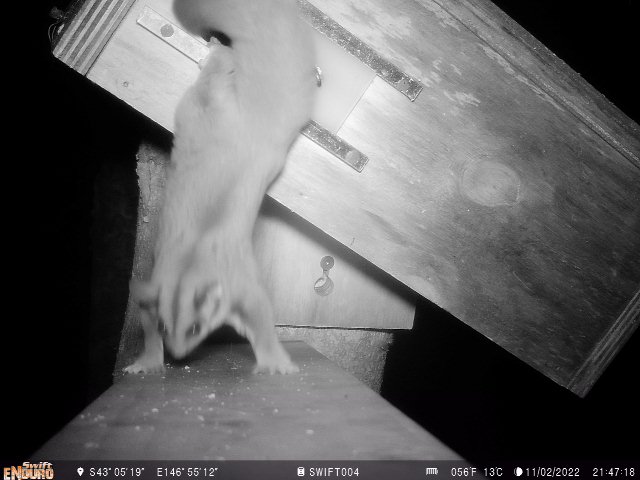When it comes to planning actions to protect the critically endangered Swift Parrot in Tasmania, it may come as a surprise that an important piece of the puzzle is finding out the type of nest boxes that Sugar Gliders prefer.
Once listed as a protected species in Tasmania and undeniably endearing, a 2018 study concluded that Sugar Gliders were not native to the island but were introduced sometime in the 1800s. And they don’t just have a sweet tooth. In fact, predation by introduced Sugar Gliders is one of the most urgent threats facing Swift Parrots, with eggs, nestlings and even adult mother birds all on the Sugar Gliders’ menu. A study from 2015 found that predation by introduced Sugar Gliders is one of the main threats to Swift Parrots, without intervention, Swift Parrot populations could decline by as much as 94% within two decades.
Since 2018, NRM South has been trailing different methods to manage Sugar Gliders as part of a project to protect this iconic migratory parrot, funded by the Australian Government’s National Landcare Program. Results so far have been mixed and have highlighted that, without a better understanding of how Sugar Gliders have adapted to the Tasmanian landscape, future control programs will likely continue to have variable outcomes.
To address this issue, NRM South is coordinating field work to try and find out more about the factors that influence the types of nest boxes that Sugar Gliders prefer. While similar studies on the mainland have shown that habitat type, tree size and topography can all play a role, these investigations have not been carried out in Tasmania until now. It is hoped that this information will help to identify the best way to manage Sugar Gliders.
Maudie Brown, Senior Project Officer in NRM South’s Environment Program, noted that it was often important to take a step back when developing a broader wildlife management approach. ‘Sugar Gliders are one of the few predators that can squeeze into a Swift Parrot nest and are a key the cause of nest failure on mainland Tasmania. Effectively addressing this issue remains one of the biggest ongoing challenges in trying to help these birds survive. Our efforts to control Sugar Gliders so far have shown us that we really need to know more about the behaviour of Sugar Gliders in Tasmania. We’re hoping that the results of our current field program can give us important insights into what Sugar Gliders look for when choosing a nest, to help us develop a better approach to future management of Sugar Gliders, and ultimately reduce their impact on Swift Parrots.’
NRM South have set up 80 nest boxes across two sites in Tasmania’s southern forests. Information is being collected on whether factors such as tree size, bark roughness and front or rear nest box access, influence which nest boxes are used by Sugar Gliders. The nest boxes are currently being monitored closely, and the results will be analysed in the coming months.
This project is supported by NRM South through funding from the Australian Government’s National Landcare Program.
